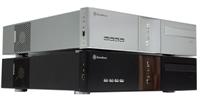The Silverstone LC11 Micro-ATX HTPC Case
As the old saying goes, "Times are a changing". When the personal computer first caught on, word processing and text based gaming was all the rage, and then there was this thing called the "Internet" on the rise. Today, the Internet is at the center of the technological universe and the PC has become a powerful tool commonly used in everyday life. Today's PCs have a myriad of uses from running the latest games to controlling all of the electrical components in our homes. The possibilities available to the average consumer are now only limited by imagination and budget.
One of the more popular, and natural progressions for the PC is in the Home Theater. With digital media being a major driving force in the industry, it only seems natural that the PC would evolve in this direction. What started out as more of a hobby for some has now become a thriving industry, producing full fledged media centers that bring a host of new features to the media experience.
Building your own HTPC is not as hard as it once was. Many can even pull together a good unit with spare components they have just lying around. Once all of the components are collected, all you need is a case and software and you are ready to start building. When choosing a case, however, there are several options to ponder. For those not all that interested in appearances, a standard case or mini-PC will do the job just fine. However, if you want to build a custom machine that blends into your current Home Theater setup, you're going to want a specialized case. While these can be a bit more costly, the end result is far more impressive in appearance and functionality than your average computer case.
Today, we are going to review one of the more impressive offerings in the HTPC case market, as we take a look at the Silverstone LC11. This unit aims to blend nicely with your home theater components, while employing a combination of cooling components and a custom layout to combat the biggest problem with HTPCs, heat. Let's take a look and see what the LC11 from Silverstone is all about.
|
The main selling point for the LC11, aside from its good looks, is the innovative cooling design. With heat being a major factor with any PC setup, it is even more important with these types of cases where good airflow can be a major problem due to size limitations. With the LC11, Silverstone has come up with a relatively well thought out design that allows the case to breathe with ease without generating excessive noise from added case fans.
When we look at the basic design, we see that several strategically placed fans and case openings can make all the difference. As the diagram shows, airflow is drawn in from the front of the case and is drawn across the motherboard assembly and exhausted through the PSU and a side fan. The bottom of the unit also has a large screened opening above the CPU fan to also allow relatively unobstructed outside air to flow across the CPU. As the imagery shows, it is a fluid design that is constantly exchanging air in the case, keeping temperatures in check.
The retail package seems a bit spartan at first, but Silverstone does provide a good collection of essential hardware. A hardware box comes with more than enough screws to mount the motherboard, hard drives and CD/DVD-ROM and several nylon ties are also included to help tame excess wiring. A custom riser card is included to orient the AGP and PCI slots so they are perpendicular to the motherboard, allowing full sized AGP and PCI cards to be used. The unit ships with a static cling wrapper applied to the top to protect the finish of the LC11. Aside from that, the rest of the components reside in the case, which is where we will turn our attention to next.










